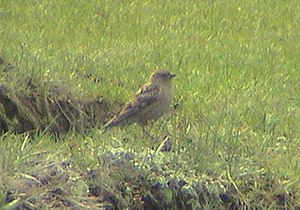Forest snow bull
| Forest snow bull | ||||||||||||
|---|---|---|---|---|---|---|---|---|---|---|---|---|

Forest snow bull |
||||||||||||
| Systematics | ||||||||||||
|
||||||||||||
| Scientific name | ||||||||||||
| Leucosticte nemoricola | ||||||||||||
| ( Hodgson , 1836) |
The forest snow bull ( Leucosticte nemoricola ), also called forest rose finch , is a species from the goldfinch-like subfamily . The species occurs in two subspecies exclusively in Asia and lives there in the mountains.
Appearance
The forest snow bull reaches a body length of fifteen to sixteen centimeters. A sexual dimorphism is poorly developed. Adult males have a reddish tinge on the head, neck, back and chest. The forest snow bull is very similar to the matted snow bull . However, this one is lighter in color than the forest snow bull and slightly larger.
The top of the body is dark brown with light brown stripes. The elytra are whitish. The black-brown wings have whitish edges. The reins and the over-eye stripe are gray. The brown ear covers are striped with gray. The underside of the body is gray-brown. The under tail-coverts are dark brown and have white seams. The eyes are red. The beak and feet are dark brown.
Distribution and way of life
The forest snowfinch is found from Afghanistan and Pakistan to the Altai and western China . It is a species that inhabits high mountain areas. The forest snow bull is usually found at altitudes between 3,500 and 5,500 meters. Its habitat are glacier moraines, scree slopes and mountain slopes with grass and dwarf trees. The nest is built near the ground and is found in crevices in the rock, between rubble and bushes. The clutch comprises three to six eggs. The incubation period is twelve to thirteen days. During the first days of life, only the female feeds.
supporting documents
Individual evidence
- ↑ Bielfeld, p. 64
literature
- Horst Bielfeld : siskins, giraffe, bullfinches and grosbeak. Verlag Eugen Ulmer, Stuttgart 2003, ISBN 3-8001-3675-9 .
Web links
- Leucosticte nemoricola inthe IUCN Red List of Threatened Species 2013.1. Listed by: BirdLife International, 2012. Retrieved September 8, 2013.